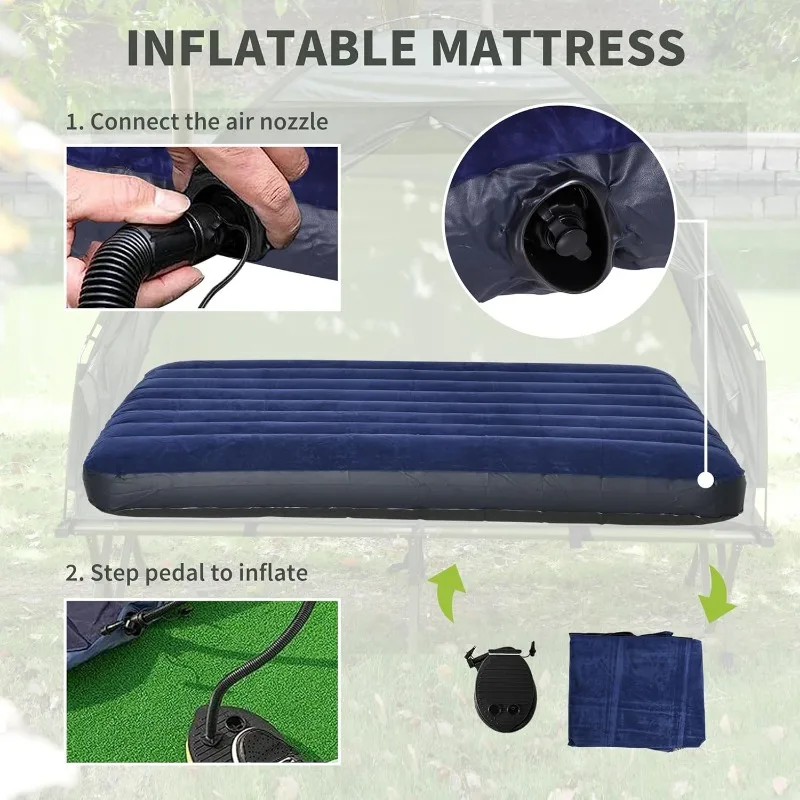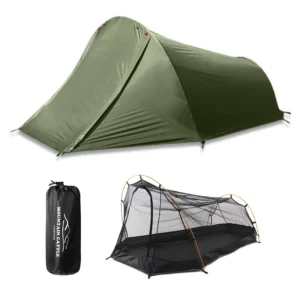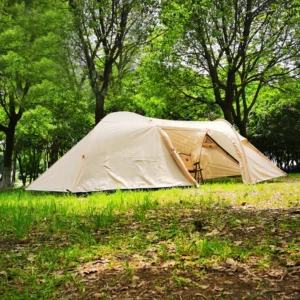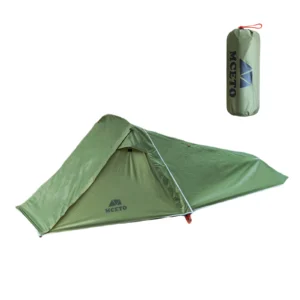Understanding Why Snow Camping Demands Specialized Tents
Snow camping isn’t just regular camping in colder weather—it’s an adventure that exposes you to some of nature’s most challenging conditions. Unlike fair-weather outings, winter camping involves extreme temperatures that can plummet to -20°F to 0°F (-29°C to -18°C), creating an environment where your shelter becomes your lifeline rather than just a place to sleep.
Standard camping equipment simply won’t cut it in these conditions. Snow camping presents unique challenges that demand specialized solutions:
- Extreme cold that requires superior insulation and heat retention
- Heavy snow loads that can collapse inadequately structured tents
- Fierce winter winds that test the limits of stakes, poles, and fabrics
- Moisture management challenges from snow, condensation, and body heat
The difference between 3-season and 4-season tents goes far beyond simple labeling. While 3-season tents prioritize ventilation, light weight, and moderate weather protection, 4-season tents feature robust pole structures, thicker fabrics, minimal mesh, and reinforced anchor points. Understanding these fundamental shelter options for two campers is crucial before venturing into winter landscapes.
Using inadequate shelter in winter conditions isn’t just uncomfortable—it can be dangerous. Hypothermia, frostbite, and exposure become real risks when your shelter fails in sub-freezing temperatures. The specialized 4-season winter 2-person tents available today represent life-saving technology, not just upgraded camping gear.
Structural Strength: The Foundation of Winter Tent Performance
Robust Pole Systems: The Skeleton of Snow Resistance
The pole structure of a winter tent is arguably its most critical component, serving as the foundation that keeps you safe when snow begins to accumulate. Unlike summer tents, snow camping shelters must support potentially hundreds of pounds of snow weight without collapsing.
Superior pole materials make all the difference in winter performance:
- 7000-series aluminum: Significantly stronger than the 6000-series found in 3-season tents
- Carbon fiber composites: Excellent strength-to-weight ratio for premium models
- Increased diameters: Winter tent poles typically measure 10-11mm compared to standard 8.5mm poles
- Reinforced connectors: Heavy-duty hubs and intersections prevent failure points
The geometry of the tent is equally important as material strength. Choosing the ultimate compact shelter for two in winter conditions means understanding these crucial design differences:
- Geodesic designs: Multiple pole crossings create exceptional strength against snow loading
- Dome structures: Shed snow naturally and resist wind from all directions
- Tunnel designs: Offer excellent space-to-weight ratios with proper guy-out points
Even the best design must consider practical winter realities—most notably the challenge of assembly with cold hands or while wearing gloves. Color-coded poles, oversized connection points, and logical setup sequences are essential features of well-designed winter tents found in our heavy-duty 4-season tent collection.
Weather-Resistant Fabrics: Your Shield Against Winter
The fabric of your snow tent represents your primary barrier against the elements, making material selection crucial for winter survival. Unlike lightweight summer fabrics, winter tent materials prioritize strength and weather resistance over minimal weight.
| Feature | 3-Season Tent | 4-Season Winter Tent |
|---|---|---|
| Fabric Denier | 20D-40D | 70D-150D |
| Material | Silnylon/Silpoly | Ripstop nylon with heavy coatings |
| Waterproof Rating | 1200-2000mm | 3000-5000mm |
| UV Protection | Moderate | Enhanced for high-altitude exposure |
Denier ratings (a measure of fabric thickness) become especially important in winter. While summer tents might use 20-40 denier fabrics to save weight, quality snow tents utilize 70+ denier materials that resist tearing under snow loads and constant wind pressure.
The fabric battle between ripstop nylon and polyester takes on new importance in winter conditions. While polyester resists UV damage and stretching when wet, nylon typically offers superior tear strength—critical when stakes and guylines are under extreme tension during winter storms. Mastering tent insulation for year-round camping requires understanding these material differences and their performance characteristics in extreme cold.
Specialized coatings add another dimension to winter fabric performance, with silicone, polyurethane, and multiple-layer treatments providing enhanced water resistance, durability, and flexibility in freezing temperatures.
Reinforced Construction Points: Preventing Failure When It Matters Most
Even the strongest fabrics and poles are only as good as the points where they connect. Winter tents demand reinforcement at every critical stress point:
- Stake loops and guyline attachments: Reinforced with additional layers of fabric and bar tacking
- Pole intersections: Strengthened with extra material and strategic stitching patterns
- Zipper endpoints: Reinforced to prevent tearing under tension
- Seams: Double or triple stitched with additional seam tape or welding
These reinforcement techniques create critical fail-safes when your tent is battling fierce winter conditions. Double stitching with high-tensile thread, strategic bar tacking at high-stress points, and webbing reinforcements distribute load across wider areas of fabric.
The most vulnerable areas—where poles insert into fabric, where guylines attach, and where different panels connect—receive extra attention in quality winter tents, often incorporating small metal reinforcements or extra fabric panels to disperse tension.
Weatherproofing: Keeping Winter’s Worst at Bay
Superior Waterproofing: Staying Dry When Everything Is Frozen
While it might seem counterintuitive to worry about waterproofing in freezing temperatures, moisture management remains critical in winter camping. Snow melts against warm surfaces, temperatures fluctuate, and body heat creates condensation—all requiring robust waterproofing solutions.
Hydrostatic head ratings (a measure of water resistance) must be substantially higher for snow tents than for standard camping shelters:
| Tent Type | Minimum Hydrostatic Head | Recommended Rating |
|---|---|---|
| 3-Season | 1200mm | 1500-2000mm |
| Snow/Winter | 2000mm | 3000-5000mm |
This increased water resistance comes from the waterproof camping tent designs that incorporate:
- Advanced seam construction: Taped seams are standard, while welded seams offer superior performance in extreme conditions
- Durable water repellent (DWR) treatments that cause water to bead and roll off rather than saturating fabric
- Multiple coating layers on both the fly and floor to ensure long-term waterproofing
Equally important is maintaining these waterproof treatments throughout the life of your tent. Silicone-treated fabrics generally maintain their water resistance longer than polyurethane coatings, though both require periodic maintenance—especially after extended use in harsh conditions.
Comprehensive Wind Resistance: Standing Strong Against Winter Storms
Winter winds create forces that can destroy inadequate shelters within minutes. Quality snow tents combat these forces through:
- Aerodynamic profiles: Low, rounded shapes that allow wind to flow around rather than catch the tent
- Multiple guyline attachment points: Often 8-12 points compared to 4-6 on standard tents
- Adjustable tensioning systems: Allow for tightening without leaving the tent during storms
- Strategic pole placements: Creating structural integrity against pressure from any direction
Wind tunnel testing demonstrates dramatic performance differences between tent designs, with geodesic and tunnel configurations typically showing superior stability in high winds compared to more vertical wall designs.
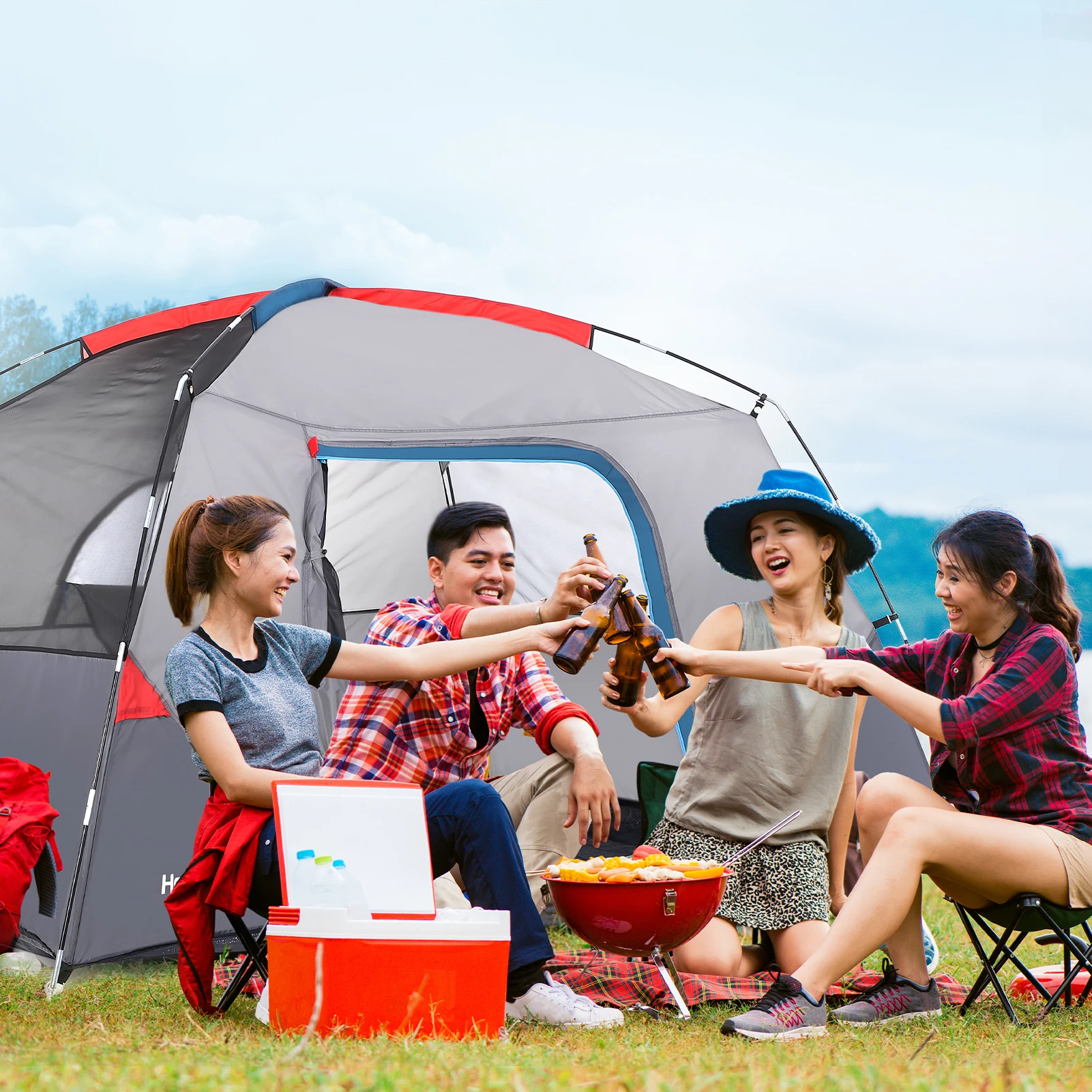
Staking techniques also change dramatically in snow, with specialized snow stakes, deadman anchors (buried objects like stuff sacks filled with snow), or ice anchors replacing standard tent pegs. The best windproof tents for cold weather incorporate reinforced stake loops positioned to maximize stability from multiple directions.
Snow-Specific Features: Specialized Design Elements
True winter tents incorporate specialized features you won’t find on standard camping shelters:
- Snow skirts/flaps: Fabric extensions at the base of the tent that can be buried in snow, creating a wind-tight seal and preventing spindrift from entering
- Extended vestibules: Providing crucial protected space for gear storage and cooking away from sleeping areas
- Steep roof angles: Designed specifically to shed snow loads effectively, preventing dangerous accumulation
- Reinforced guy points: Allowing for secure anchoring even in soft snow conditions
The snow load capacity of specialized winter camping tents typically ranges from supporting 12-24 inches (30-60 cm) of fresh snow—a critical safety feature when unexpected storms hit your campsite.
Vestibules designed specifically for snow conditions feature steeper walls, larger footprints, and often optional floor systems that can be removed for cooking safety while maintaining protection from the elements.
Thermal Management: Balancing Warmth and Condensation
Double-Wall vs. Single-Wall Construction: Choosing Your Winter Defense
The debate between double-wall and single-wall construction takes on new importance in winter conditions, with each offering distinct advantages:
Double-Wall Construction:
– Creates insulating air barrier between inner tent and fly
– Superior condensation management through separation of moisture layers
– More versatile for variable conditions
– Typically 15-20% heavier than comparable single-wall designs
Single-Wall Construction:
– Faster setup in harsh conditions
– Less weight for comparable strength
– Often uses more advanced (and expensive) breathable-waterproof fabrics
– More prone to condensation issues in certain conditions
Temperature testing shows that the air gap in double-wall tents can increase interior temperatures by 5-10°F (3-6°C) compared to single-wall designs in identical conditions—a significant difference when temperatures drop below zero.
Understanding these fundamental camping shelter options for two helps you select the appropriate design for your specific winter activities, whether that’s basecamp-style expeditions or fast-and-light alpine climbing.
Winter-Ready Ventilation: The Condensation Solution
Counterintuitively, ventilation becomes more critical as temperatures drop. During sleep, each person produces approximately 1-2 pints (0.5-1 liter) of moisture through respiration and perspiration—moisture that will freeze on contact with tent walls if not properly vented.
Effective winter ventilation systems include:
- Adjustable upper vents that can be operated while fully inside the sleeping bag
- Protected intake designs that prevent snow from entering while allowing air circulation
- Multiple vent points creating directional airflow across the tent
- Vestibule vents that reduce cooking condensation while maintaining heat
The positioning of these vents becomes crucial in winter designs, with optimal systems creating chimney effects that allow warm, moist air to escape while minimizing cold drafts on sleeping occupants.
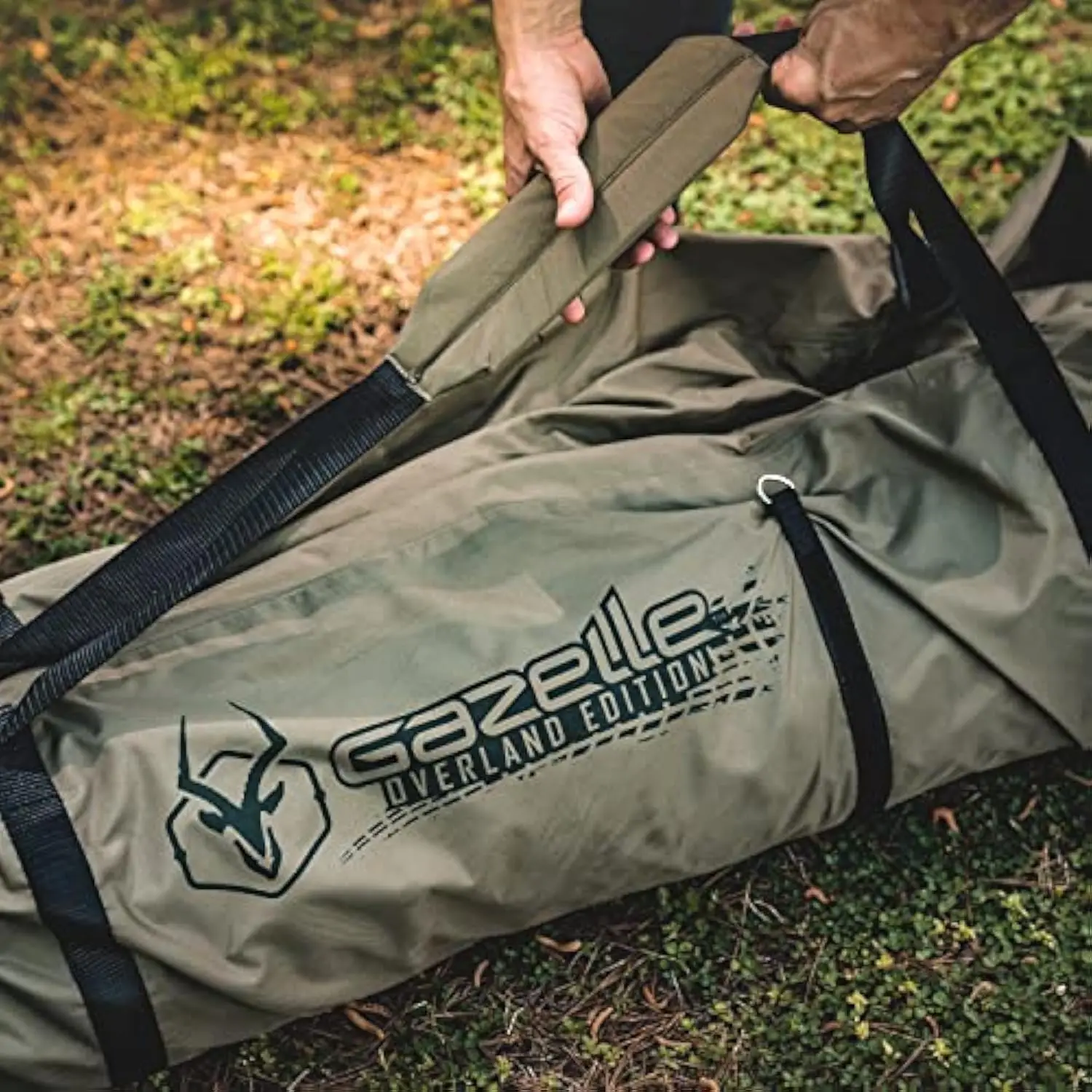
Livability: Comfort in the Frozen Wild
Winter-Worthy Space: Room for You and Your Gear
Winter camping requires significantly more interior space than warm-weather adventures. Bulky sleeping bags, extra clothing layers, boot liners, and electronics that can’t survive in the cold all demand interior storage space.
For comfortable winter camping, look for:
- Minimum floor space: 15-20 square feet (1.4-1.9 square meters) per person—about 25% more than summer requirements
- Height considerations: Enough clearance to sit up and change clothing without touching walls
- Strategic sloping: Walls designed to maximize usable space while still shedding snow effectively
Understanding what size tent is good for 2 people becomes even more important when winter gear is involved. The ideal balance provides enough space for occupants and essential gear without creating an excessively large area that’s difficult to heat with body warmth.
Essential Vestibules: Your Winter Gear Management System
Vestibules transform from convenient features to essential systems in winter camping. These protected external areas serve multiple critical functions:
- Gear storage: Keeping snow-covered items outside sleeping areas
- Transition zones: Removing snowy outer layers before entering the main tent
- Cooking spaces: Providing protected areas for stove operation (with appropriate ventilation)
- Boot storage: Preventing footwear from freezing overnight
Quality winter tents feature vestibules with 8-10 square feet (0.75-0.93 square meters) at minimum, with many expedition models offering significantly more. The best backpacking tent vestibule designs include multiple access points and adjustable configurations to adapt to changing conditions.
Heavy Duty 4 Season Tent, Mountaineering Tent, Winter Camping Tent
$870.40 Select options This product has multiple variants. The options may be chosen on the product pageCompact Backpacking Tent, Lightweight Backpacking Tent, Waterproof Camping Tent
$335.52 Select options This product has multiple variants. The options may be chosen on the product pageUltralight Backpacking Tent, Ultralight Dome Tent, Winter Camping Tent
Price range: $369.63 through $370.07 Select options This product has multiple variants. The options may be chosen on the product pageCamping Tent with Vestibule, Waterproof Camping Tent
Price range: $407.89 through $479.48 Select options This product has multiple variants. The options may be chosen on the product pageHeavy Duty 4 Season Tent, Ultralight Freestanding Tent, Winter Camping Tent
$3,722.66 Select options This product has multiple variants. The options may be chosen on the product pageBackpacking Tent with Vestibule, Freestanding Backpacking Tent, Lightweight Backpacking Tent
Price range: $446.89 through $447.22 Select options This product has multiple variants. The options may be chosen on the product page
Cold-Weather Door Designs: Access Without Heat Loss
Door design dramatically impacts both convenience and thermal efficiency in winter tents. Key features include:
- D-shaped or oval openings: Providing easier access while wearing bulky clothing
- Large, glove-friendly zipper pulls: Typically using #8-10 YKK zippers (larger than standard tent zippers)
- Dual-slider configurations: Allowing partial opening for ventilation control
- Comprehensive storm flaps: Covering zipper tracks to prevent drafts and freezing
Multiple doors serve winter-specific functions beyond convenience, creating options for ventilation control and protected entry/exit regardless of wind direction. The best designs allow for door operation without disturbing interior occupants—valuable when nature calls during long winter nights.
Interior Organization: Managing Gear in Limited Space
Thoughtful organization becomes essential when limited space meets abundant winter gear. Effective interior features include:
- Elevated mesh pockets: Positioning gear away from tent walls where condensation forms
- Ceiling gear lofts: Utilizing otherwise wasted overhead space
- Multiple attachment points: For hanging wet gloves and socks to dry
- Dedicated electronics pockets: Keeping batteries and devices close to body heat
These organization systems transform a crowded tent into an efficient winter shelter, with places for everything from headlamps to boot liners. Strategic placement of these features—like positioning pockets near the door for frequently accessed items—enhances usability in challenging conditions.
Practicality: Using Your Tent in Extreme Conditions
Winter Setup Efficiency: Pitching in Challenging Conditions
The best tent design means little if you can’t set it up in howling winds and sub-freezing temperatures. Winter-specific setup features include:
- Color-coded poles and connection points: Visible even in low light or whiteout conditions
- External pole sleeves or clips: Manageable while wearing gloves
- Freestanding or semi-freestanding designs: Allowing initial setup without staking in deep snow
- Unified pitching systems: Where the inner tent and fly can be set up simultaneously
Experienced winter campers can typically pitch specialized snow tents in 5-10 minutes, but this efficiency comes from both thoughtful design and practice. Mastering two-person lightweight tent setup techniques before encountering harsh conditions can make a significant difference in comfort and safety.
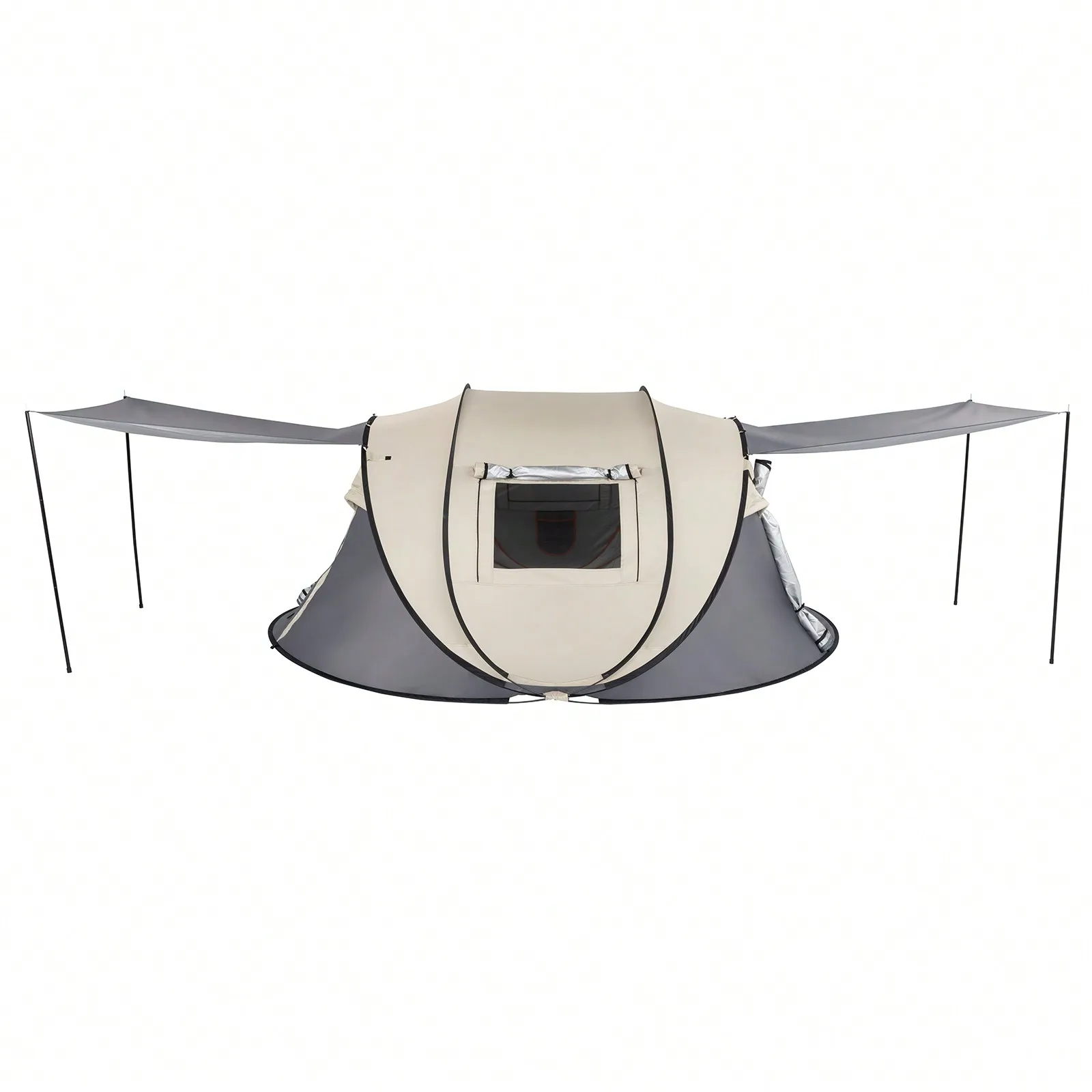
Platform preparation becomes equally important in winter camping, with techniques like stomping down a tent footprint with snowshoes or skis creating a solid foundation before pitching.
Weight and Packability: Balancing Protection and Portability
Winter tents inevitably weigh more than their 3-season counterparts, but significant weight variations exist between models:
| Tent Type | Typical Weight Range | Packed Size |
|---|---|---|
| Lightweight Winter | 5-7 lbs (2.3-3.2 kg) | 6” x 18” (15 x 46 cm) |
| Standard Winter | 7-9 lbs (3.2-4.1 kg) | 7” x 20” (18 x 51 cm) |
| Expedition | 9-12+ lbs (4.1-5.4+ kg) | 8” x 22”+ (20 x 56+ cm) |
This weight premium delivers critical protection advantages, and many four-season tents built for durability allow for splitting components among group members to distribute the load. The pole set, fly, and inner tent can often be carried separately, making the weight more manageable for teams.
Choosing the Right Snow Tent for Your Adventure
Selecting the perfect snow tent requires matching features to your specific winter activities:
- Alpine mountaineering: Prioritize strength-to-weight ratio, wind resistance, and rapid setup
- Base camp expeditions: Focus on livable space, multiple vestibules, and maximum stability
- Forest winter camping: Consider snow load strength with some protection from winds
- Open tundra/exposed terrain: Maximum wind resistance becomes the priority
Your environment dramatically impacts which features matter most:
– Dense forest: Protection from falling snow and branches
– Alpine zones: Extreme wind resistance and minimal snow collection surfaces
– Open snowfields: Stakes that work in soft snow and designs that prevent drifting
Budget considerations inevitably factor into decisions, but remember that winter tents represent safety equipment, not just comfort items. Entry-level snow-capable tents start around $300-400, mid-range options run $400-700, and expedition-grade shelters often exceed $700-1000.
Essential Maintenance for Winter Tent Performance
Proper maintenance dramatically extends the life and reliability of winter tents:
- Regular snow removal: Brush accumulation from the tent before it builds up significantly
- Proper drying: Always dry completely before storage, even if it means setting up in your living room after trips
- Stake and guyline inspection: Check for bending or fraying before each trip
- Seam sealing maintenance: Reapply treatments as needed, especially before major expeditions
A winter-specific repair kit should include:
- Seam sealer appropriate for your tent’s fabric
- Tent pole repair sleeves
- Repair tape compatible with your tent material
- Extra guylines and cord locks
Conducting a thorough pre-trip inspection of all components prevents discovering critical issues when you’re miles from civilization in freezing conditions.
Comparing Top Winter Tent Designs: Finding Your Perfect Match
Each winter tent design philosophy offers distinct advantages:
| Design | Snow Performance | Wind Resistance | Weight | Livability | Best Use |
|---|---|---|---|---|---|
| Geodesic | Excellent | Excellent | Moderate | Good | All-around expedition |
| Tunnel | Good | Very good (when oriented) | Better | Excellent | Base camping, protected sites |
| Pyramid/Teepee | Very good | Good | Best | Fair | Ultralight winter trips |
Hybrid designs increasingly combine elements of multiple configurations, like tunnel tents with geodesic-style crossing poles at key points or dome tents with extended tunnel vestibules.
At Explore Elements, we’ve tested these designs across varied winter conditions to curate our selection of winter shelters that truly perform when it matters most. The perfect winter tent balances protection, weight, livability, and setup simplicity for your specific adventure style—because when the temperature drops and the snow begins to fall, your shelter choice becomes the cornerstone of winter camping success.

